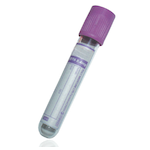Suitable Specimen Types
- EDTA Whole Blood
- Special Collection Procedures Apply
Sample Processing in Laboratory
Place in Trace Element rack in Send Away Fridge.Sample Preparation
Blood is preferred sample. No need to centrifuge
Turnaround Time
5 working daysSample Stability
4 oC
Blood Chromium
General Information
Occupational exposure to chromium represents a significant health hazard. Chromium is used extensively in the manufacture of stainless steel, chrome plating, tanning of leather, as a dye for printing and textile manufacture amd as a cleaning solution. The toxic form of chromium, Cr[VI], can only be formed in a strong oxidizing environment as might be found when Cr[III] is exposed to high temperatures in the presence of oxygen (e.g. in high voltage electroplating). Inhalation of the vapours of Cr[VI] causes erosion of the epithelium of the nasal passages and produces squamous-cell carcinomas of the lung.
Situations when chromium may be requested include:
- In acute poisoning, measurement of Cr in whole blood and urine is the approach of choice.
- For suspected PN overload, blood measurement is used.
- For on-going occupational exposure, urine is the preferred specimen. In cases where exposure has ceased, or has occurred sporadically, within the last four weeks, blood measurement is more useful. In all circumstances particular care is needed to avoid contamination when collecting specimens.
- Monitoring for Cr ?deficiency? is not undertaken because (a) the problem has yet to be convincingly demonstrated in humans and (b) it is extremely difficult to collect blood without contaminating it to concentrations within the normal range.
- Concentrations in blood, plasma and urine may be elevated in individuals with metallic prosthetic joints.
It must be noted that in most cases monitoring biological specimens for Cr[VI] is neither practical or clinically useful to detect chromium toxicity because the moment it enters a cell it is reduced to non-toxic Cr[III]. The monitoring of the air at the manufacturing site for Cr[VI] is the usual way to test for potential Cr[VI] exposure.
Patient Preparation
None
Notes
Urine Chromium also available (20mL) required.
Reference Range
Normal values: <15 nmol/L
MHRA threshold (7ppb) for patients with MoM hip joints: 135 nmol/L
Specifications
- EQA Status: TEQAS
